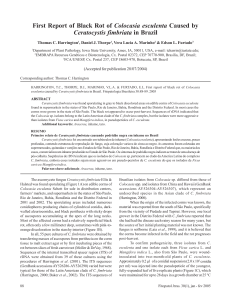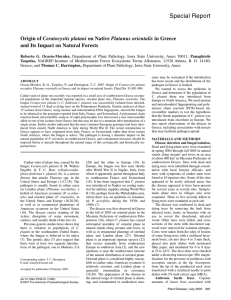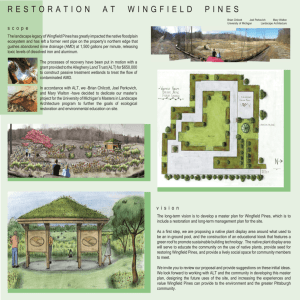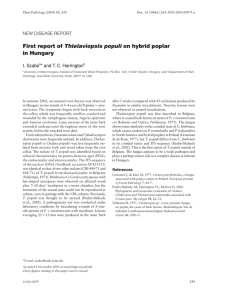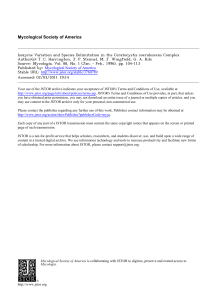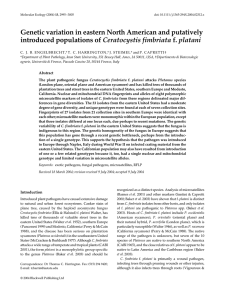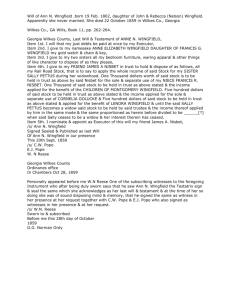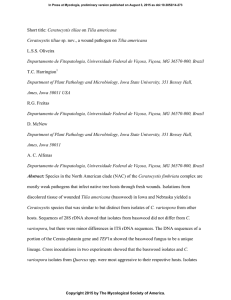743 R. C. W I T T H U H N
advertisement
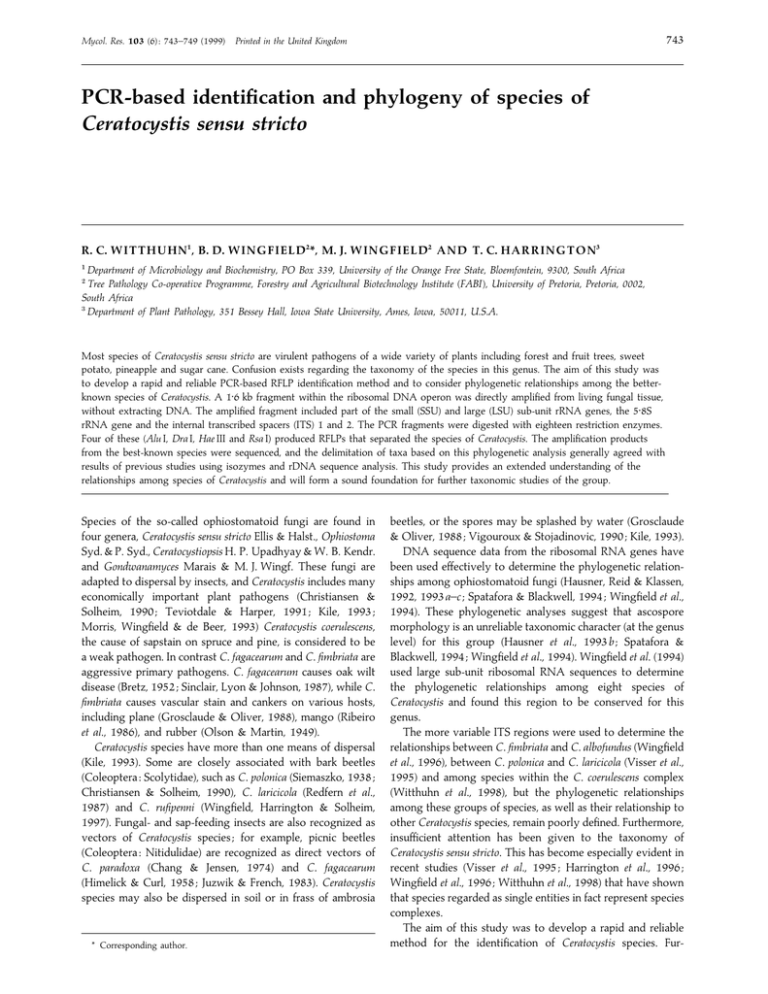
Mycol. Res. 103 (6) : 743–749 (1999) 743 Printed in the United Kingdom PCR-based identification and phylogeny of species of Ceratocystis sensu stricto R. C. W I T T H U HN1, B. D. W I N G F I E L D2*, M. J. W I N G F I E L D2 A N D T. C. H A R R I N G T O N3 " Department of Microbiology and Biochemistry, PO Box 339, University of the Orange Free State, Bloemfontein, 9300, South Africa # Tree Pathology Co-operative Programme, Forestry and Agricultural Biotechnology Institute (FABI ), University of Pretoria, Pretoria, 0002, South Africa $ Department of Plant Pathology, 351 Bessey Hall, Iowa State University, Ames, Iowa, 50011, U.S.A. Most species of Ceratocystis sensu stricto are virulent pathogens of a wide variety of plants including forest and fruit trees, sweet potato, pineapple and sugar cane. Confusion exists regarding the taxonomy of the species in this genus. The aim of this study was to develop a rapid and reliable PCR-based RFLP identification method and to consider phylogenetic relationships among the betterknown species of Ceratocystis. A 1n6 kb fragment within the ribosomal DNA operon was directly amplified from living fungal tissue, without extracting DNA. The amplified fragment included part of the small (SSU) and large (LSU) sub-unit rRNA genes, the 5n8S rRNA gene and the internal transcribed spacers (ITS) 1 and 2. The PCR fragments were digested with eighteen restriction enzymes. Four of these (Alu I, Dra I, Hae III and Rsa I) produced RFLPs that separated the species of Ceratocystis. The amplification products from the best-known species were sequenced, and the delimitation of taxa based on this phylogenetic analysis generally agreed with results of previous studies using isozymes and rDNA sequence analysis. This study provides an extended understanding of the relationships among species of Ceratocystis and will form a sound foundation for further taxonomic studies of the group. Species of the so-called ophiostomatoid fungi are found in four genera, Ceratocystis sensu stricto Ellis & Halst., Ophiostoma Syd. & P. Syd., Ceratocystiopsis H. P. Upadhyay & W. B. Kendr. and Gondwanamyces Marais & M. J. Wingf. These fungi are adapted to dispersal by insects, and Ceratocystis includes many economically important plant pathogens (Christiansen & Solheim, 1990 ; Teviotdale & Harper, 1991 ; Kile, 1993 ; Morris, Wingfield & de Beer, 1993) Ceratocystis coerulescens, the cause of sapstain on spruce and pine, is considered to be a weak pathogen. In contrast C. fagacearum and C. fimbriata are aggressive primary pathogens. C. fagacearum causes oak wilt disease (Bretz, 1952 ; Sinclair, Lyon & Johnson, 1987), while C. fimbriata causes vascular stain and cankers on various hosts, including plane (Grosclaude & Oliver, 1988), mango (Ribeiro et al., 1986), and rubber (Olson & Martin, 1949). Ceratocystis species have more than one means of dispersal (Kile, 1993). Some are closely associated with bark beetles (Coleoptera : Scolytidae), such as C. polonica (Siemaszko, 1938 ; Christiansen & Solheim, 1990), C. laricicola (Redfern et al., 1987) and C. rufipenni (Wingfield, Harrington & Solheim, 1997). Fungal- and sap-feeding insects are also recognized as vectors of Ceratocystis species ; for example, picnic beetles (Coleoptera : Nitidulidae) are recognized as direct vectors of C. paradoxa (Chang & Jensen, 1974) and C. fagacearum (Himelick & Curl, 1958 ; Juzwik & French, 1983). Ceratocystis species may also be dispersed in soil or in frass of ambrosia * Corresponding author. beetles, or the spores may be splashed by water (Grosclaude & Oliver, 1988 ; Vigouroux & Stojadinovic, 1990 ; Kile, 1993). DNA sequence data from the ribosomal RNA genes have been used effectively to determine the phylogenetic relationships among ophiostomatoid fungi (Hausner, Reid & Klassen, 1992, 1993 a–c ; Spatafora & Blackwell, 1994 ; Wingfield et al., 1994). These phylogenetic analyses suggest that ascospore morphology is an unreliable taxonomic character (at the genus level) for this group (Hausner et al., 1993 b ; Spatafora & Blackwell, 1994 ; Wingfield et al., 1994). Wingfield et al. (1994) used large sub-unit ribosomal RNA sequences to determine the phylogenetic relationships among eight species of Ceratocystis and found this region to be conserved for this genus. The more variable ITS regions were used to determine the relationships between C. fimbriata and C. albofundus (Wingfield et al., 1996), between C. polonica and C. laricicola (Visser et al., 1995) and among species within the C. coerulescens complex (Witthuhn et al., 1998), but the phylogenetic relationships among these groups of species, as well as their relationship to other Ceratocystis species, remain poorly defined. Furthermore, insufficient attention has been given to the taxonomy of Ceratocystis sensu stricto. This has become especially evident in recent studies (Visser et al., 1995 ; Harrington et al., 1996 ; Wingfield et al., 1996 ; Witthuhn et al., 1998) that have shown that species regarded as single entities in fact represent species complexes. The aim of this study was to develop a rapid and reliable method for the identification of Ceratocystis species. Fur- Identification and phylogeny of Ceratocystis 744 Table 1. Isolates and origins of species of Ceratocystis studied and the RFLP fragment sizes using the restriction enzymes Alu I, Dra I, Hae III and Rsa I. The RFLP patterns for the four restriction enzymes were uniform within species Origin Host C. fagacearum (Bretz) J. Hunt CMW2037 CMW2038 CMW2039 CMW2651 (AFO43598)* CMW2658 MN, U.S.A. MN, U.S.A. MN, U.S.A. U.S.A. U.S.A. Quercus Quercus Quercus Quercus Quercus C. moniliformis (Hedgc.) C. Moreau CMW1626, IOF8667 CMW4458 CMW3782 (AFO43597) Japan China South Africa Unknown Hevea sp. Erythrina sp. C. fimbriata Ellis & Halst. from Platanus CMW1894 CMW1895 CMW1896 CMW2218 CMW2219, PREM51642 (AFO43604) CMW2220, PREM51644 CMW2228, PREM51830 CMW2242, PREM51831 CMW2324 Switzerland Switzerland Switzerland France France France Sicily Italy Switzerland Platanus Platanus Platanus Platanus Platanus Platanus Platanus Platanus Platanus C. fimbriata from Populus and Prunus CMW1270, C89 CMW2901, C685 CMW0078 CMW2911, C578 CMW2902, C686 SD, U.S.A. Quebec, Canada CO, U.S.A. CA, U.S.A. CA, U.S.A. Populus sp. Populus sp. Populus sp. Prunus sp. Prunus sp. Rsa I 400, 280, 200, 180, 150 620, 550, 280 700, 600, 250 400, 280, 200, 180, 150 620, 550, 280 700, 600, 250 400, 280, 200, 180, 150 620, 550, 280 700, 600, 250 400, 280, 200, 180, 150 620, 550, 280 700, 600, 250 400, 280, 200, 180, 150 Unknown 620, 550, 280 600, 480, 250 Dra I 440, 400, 200, 180, 150 sp. sp. sp. sp. sp. 400, 350, 260, 220, 150 720, 220, 180, 150 1600 sp. sp. sp. sp. sp. sp. sp. sp. sp. 560, 220, 180, 150 C. albofungus M. J. Wingf. De Beer & Michael Morris CMW2473, PREM51639 South Africa CMW2475, PREM51641 South Africa (AFO43605) 720, 220, 180, 150 1200, 320, 150 Acacia sp. Acacia sp. C. adiposa (E. J. Butler) C. Moreau CMW0066 CMW0071 CMW0121 CMW1622, IOF9546 (AFO43606) CMW2573, CBS136.34 CMW2575, CBS600.74 CMW3307, C299 Unknown Unknown Unknown Japan Japan Japan U.S.A. Unknown Unknown Unknown Unknown Saccharum sp. Pinus sp. Wood chips C. paradoxa (Dade) C. Moreau CMW1546 (AFO43607) Unknown Musa sp. CA, U.S.A. CA, U.S.A. Phoenix sp. Unknown C. radicicola (Bliss) C. Moreau CMW3186, CBS114.47 CMW3191, CBS146.59 (AFO43599) Dra I\Hae III double digests Alu I Isolate numbers 400, 340, 200, 180, 150 400, 340, 200, 180, 150 400, 280, 200, 180, 150 C. coerulescens (Mu$ nch) B. K. Bakshi complex : C. pinicola T. C. Harr. & M. J. Wingf. C488 England C489 England CMW1323, C490 (AFO43602) England CMW3759, C798 England Pinus Pinus Pinus Pinus C. coerulescens CMW3231, C313 CMW3235, C321 Germany Netherlands Picea sp Unknown C. resinifera T. C. Harr. & M. J. Wing. CMW3227, C276 CMW3229, C278 Norway Norway Picea sp. Picea sp. C. rufipenni M. J. Wingf. T. C. Harr. & H. Solheim CMW3247, C609 Canada Picea sp. C. virescens (R. W. Davidson) C. Moreau C70 Unknown CMW0460, C74 NY, U.S.A. (AFO43603) sp. sp. sp. sp. Quercus sp. R. C. Witthuhn and others 745 Table 1. (Cont.) Origin Host C252 C253 CMW3225, C254 C256 C262 NY, U.S.A. NY, U.S.A. NY, U.S.A. WI, U.S.A. NH, U.S.A. Acer Acer Acer Acer Acer sp. sp. sp. sp. sp. C. laricocola Redfern & Minter CMW1016 (AFO 43600) CMW3212, C177 CMW3214, C178 CMW3217, C179 CMW3219, C180 CMW3221, C181 Scotland Scotland Scotland Scotland Scotland Scotland Larix Larix Larix Larix Larix Larix sp. sp. sp. sp. sp. sp. Norway Norway Poland Picea sp. Picea sp. Picea sp. C. polonica Siemaszko CMW3208, C123 CMW3235, C321 CMW0672, C322, CBS133.38 (AFO43601) Dra I\Hae III double digests Rsa I 400, 280, 200, 180, 150 550, 510, 360 700, 600, 250 400, 280, 200, 180, 150 550, 510, 360 700, 600, 250 Alu I Isolate numbers Dra I CMW – Culture collection of M. J. Wingfield ; C – Culture collection of T. C. Harrington ; PREM – National Collection of Fungi, South Africa ; CBS – Centraal Bureau voor Schimmelcultures, Netherlands, ATCC – American Type Culture Collection, USA ; IOF – Institute for Fermentation, Japan. * GenBank Accession no. in parenthesis for those isolates selected for sequencing. thermore, DNA sequence data of the ribosomal RNA genes of the best-known species were compared in order to resolve phylogenetic relationships. MATERIALS AND METHODS Isolates Isolates of Ceratocystis spp. used in this study were obtained from a wide range of geographical areas and diverse sources (Table 1). These were grown on malt extract agar (20 g l−" malt extract and 20 g l−" agar) in Petri-dishes at room temperature for 10 d. Polymerase chain reaction PCR reactions were performed directly from the mycelium of the isolates without extracting DNA (Harrington & Wingfield, 1995). A part of the ribosomal DNA operon was amplified using the primers ITS1 and LR6 (Table 2). The amplified fragment included the 3h end of the small sub-unit (SSU) rRNA gene, the 5.8S rRNA gene, part of the large sub-unit (LSU) rRNA gene and the internal transcribed spacer (ITS) regions 1 and 2. The PCR reactions were performed as described by Witthuhn et al. (1998). The PCR products were electrophoresed in 15 g l−" agarose gels, using 0n5iTBE electrophoresis buffer, stained with ethidium bromide, and visualised using uv light. Amplification reactions were repeated at least twice for each isolate. Restriction fragment length polymorphisms Eighteen restriction enzymes (Alu I, Cfo I, Dde I, Dra I, EcoR I, Hae III, Hind II, Hind III, Hinf I, Hpa II, Pst I, Pvu II, Rsa I, Sau3 Table 2. Primers used for the generation and sequencing of the PCR products ITS1 ITS2 ITS3 ITS4 LR1 LR3 LR5 LR6 LR1R LR3R LR5R 404x* L1 Sequence (5h-3h) Source TCCGTAGGTGAACCTGCGG GCTGCGTTCTTCATCGATGC GCATCGATGAAGAACGCAGC TCCTCCGCTTATTGATATGC GGTTGGTTTCTTTTCCT GGTCCGTGTTTCAAGAC ATCCTGAGGGAAACTTC CGCCAGTTCTGCTTACC AGGAAAAGAAACCAACC GTCTTGAAACACGGACC GAAGTTTCCCTCAGGAT CCCTTTCAACAATTTCAC GGTCCGTGTTTCAAG White et al., 1990 White et al., 1990 White et al., 1990 White et al., 1990 Vilgalys & Hester, 1990 Vilgalys & Hester, 1990 Vilgalys & Hester, 1990 Vilgalys & Hester, 1990 Complement of LR1 Complement of LR3 Complement of LR5 Authors, unpublished Wingfield et al., 1994 * Binds to position 404 (5h–3h) of the large sub-unit ribosomal RNA gene of Saccharomyces cerevisiae. A, Sau96 I, ScrF I, Taq I, Xba I) were tested for RFLPs of the PCR products. The digested PCR products were separated on 20 g l−" agarose gels, using 0n5iTBE electrophoresis buffer, stained with ethidium bromide, and visualized using uv light. The sizes of the restriction products were determined against a 100 bp ladder. No fragments smaller than 150 bp were scored. DNA sequencing One isolate of each of eleven species of Ceratocystis was selected for sequencing based on the results of the RFLP study. These isolates, with their GenBank Accession no. are listed in Table 1. Petriella setifera (J. C. Schmidt) Curzi (ATCC26490, GenBank Accession no. AFO43596) was used as the outgroup taxon (Spatafora & Blackwell, 1994). In the case of C. coerulescens, it is recognized that this represents a complex of at least five species (Harrington et al., 1996 ; Identification and phylogeny of Ceratocystis ITS1 ITS3 LR1R 746 D LR3R LR5R C. fimbriata D D ITS2 ITS4 LR1 L1 404X LR3 LR5LR6 Fig. 1. Diagrammatic representation of the 1600 bp PCR fragment of the species of Ceratocystis used in this study. The positions of the 13 sequencing primers are indicated with arrows. Wingfield et al., 1997 ; Witthuhn et al., 1998 ; Harrington & Wingfield, 1998), but only one, C. pinicola, was selected to represent the complex. The PCR fragments were purified using Wizard PCR Preps (Promega Corporation, U.S.A.) or Microcon Microconcentrators (Amicon, Inc., U.S.A.). Both strands of the PCR products of nine of the 12 isolates were sequenced with 13 primers (Table 2, Fig. 1) using the fmol DNA sequencing kit (Promega Corporation, U.S.A.). Three of the isolates were sequenced using an ABI PRISM 377 DNA sequencer (PerkinElmer, U.S.A.) at the DNA sequencing facility at Iowa State University. The DNA sequence data were submitted to GenBank. The nucleotide sequences were manually aligned. Phylogenetic relationships among species were determined using the heuristic search option in PAUP, with gaps treated as missing data (Swofford, 1993). Bootstrap values (Felsenstein, 1985) were determined from 100 replicates. D H R R RH D H R R RH D H R RH D H R RH D C. virescens C. radicicola C. laricicola C. polonica D C. pinicola Scale 1 kb 1·5kb Fig. 3. Restriction maps of the restriction enzymes (Dra I, Hae III and Rsa I), inferred from sequence analysis, used to distinguish closely related Ceratocystis species. D – Dra I, H – Hae III, R – Rsa I. A A A AA A A A A AA A A A A AA A A DNA sequencing RFLPs The PCR amplifications of the species of Ceratocystis under consideration produced PCR products that were 1n6 kb in size. Of the 18 restriction enzymes tested Alu I, Dra I, Hae III and C. fimbriata A AA A A A A AA A A A A A C. albofundus A A D Rsa I produced RFLP patterns that were used to distinguish the species. The restriction enzyme maps in Figs 2 and 3 are based on the actual DNA sequences. Restriction digests using Alu I (Table 1, Fig. 2) produced unique restriction patterns for C. moniliformis, C. fagacearum and C. fimbriata isolates from Populus and Prunus (Table 1). The groups of species that had the same RFLP patterns after Alu I digests are : C. fimbriata isolates from Platanus spp. and C. albofundus, C. adiposa and C. paradoxa, and species in the C. coerulescens complex and C. radicicola. Ceratocystis adiposa and C. paradoxa could not be separated based on the RFLPs produced by any of the restriction enzymes tested. Many of the other closely related species that had the same RFLP patterns using Alu I were, however, separated from each other based on the RFLPs produced by Dra I, Hae III and Rsa I (Table 1, Fig. 3). The restriction patterns produced after a digestion with Dra I enabled distinction between Platanus isolates of C. fimbriata and C. albofundus. Double digestions using the enzymes Dra I and Hae III were used to separate C. coerulescens and C. virescens from C. laricicola, C. polonica and C. radicicola. Ceratocystis coerulescens isolates were distinguishable from C. virescens isolates based on Rsa I digests. Rsa I was also used to distinguish C. radicicola from C. laricicola and C. polonica. The recently described C. pinicola, C. resinifera and C. rufipenni could not be distinguished from C. coerulescens based on the RFLP analyses. RESULTS C. virescens C. radicicola C. laricicola C. polonica C. pinicola D C. albofundus AA A AA C. paradoxa C. adiposa C. moniliformis C. fagacearum Scale 1 kb 1·5kb Fig. 2. Alu I (A) restriction maps, inferred from sequence analysis, of the PCR fragments amplified from all the Ceratocystis species studied. The aligned DNA sequences of the representative species of Ceratocystis were 1731 bp in size after gaps were inserted to achieve the alignment. Within the ITS region, high variability was observed between the DNA sequence of the various R. C. Witthuhn and others 747 P. setifera 13 6 14 9 75 9 C. radicicola 3 95 9 C. paradoxa 1 C. laricicola 3 81 112 10 83 7 21 100 C. adiposa C. fagacearum 12 23 C. moniliformis 5 64 6 C. polonica 8 C. pinicola C. virescens C. fimbriata 17 C. albofundus Fig. 4. The most parsimonious tree (tree length l 288) produced from the DNA sequence of part of the large sub-unit ribosomal RNA gene. Bootstrap values (100 replicates) greater than 50 % are indicated at the bottom of the branches and the number of base substitutions are indicated at the top of the branches. species, with numerous insertions–deletions, which made the alignment of the sequences in this region very difficult. In contrast, the large sub-unit rRNA gene (1087 bases in total) was found to be relatively conserved. A heuristic search from the aligned DNA sequence data (1081 characters) of the large sub-unit rRNA gene produced one most parsimonious tree (Fig. 4) of 288 steps (CI l 0n788, HI l 0n212, RI l 0n667). The tree was rooted to Petriella setifera, the outgroup species. Two major clades were found within Ceratocystis : C. fimbriata and C. albofundus grouped together (100 % bootstrap value), sister to the clade (95 % bootstrap value) formed by the other nine Ceratocystis species under consideration. Relationships among the nine other species were not clear, but C. moniliformis, C. fagacearum and C. adiposa formed a single, weakly supported clade (75 % bootstrap value). The C. coerulescens complex (C. laricicola, C. polonica, C. pinicola and C. virescens) formed another weakly supported (83 % bootstrap value) clade. Much of the alignment of the DNA sequence data within the ITS1 and ITS2 regions proved to be ambiguous for all the species studied. A second analysis was performed on the DNA sequence data of the ITS and LSU regions after all characters of ambiguous alignment were removed (378 of the 1731 characters removed), with most of the removed characters in the ITS1 and ITS2 regions. A single most parsimonious tree of 420 steps (CI l 0n800, HI l 0n200, RI l 0n648) was produced (data not shown), and the topology was found to be similar to the tree produced when only the LSU sequence data was analysed (Fig. 4). Petriella setifera was again defined as the outgroup. Ceratocystis fimbriata and C. albofundus grouped together (100 % bootstrap value) and formed a clade sister to the clade formed by all the other Ceratocystis species studied (96 % bootstrap value). C. moniliformis, C. fagacearum and C. adiposa formed a single clade (60 % bootstrap value). The members of the C. coerulescens complex formed a clade (89 % bootstrap value), and there was support (92 % bootstrap value) for the clade of species that occur on conifers (C. pinicola, C. polonica and C. laricicola). DISCUSSION In this study, the best known species of Ceratocystis have been characterized based on sequence data and RFLP analyses. The results of the sequence analyses generally support those of earlier studies (Hausner, Reid & Klassen, 1993 a, c ; Visser et al., 1995 ; Harrington et al., 1996 ; Wingfield et al., 1996). The RFLP comparisons of a large number of isolates has shown that it is possible to distinguish most of the species using this reliable and quick technique. Ceratocystis fimbriata is a well known pathogen on a wide variety of hosts, including sweet potatoes, from which it was first described (Halsted, 1890). Ceratocystis albofundus is a pathogen of Acacia mearnsii in South Africa (Morris, Wingfield & de Beer, 1993) and was recently shown by ITS sequence analysis and morphology to represent a distinct taxon similar to, but quite distinct from, C. fimbriata (Wingfield et al., 1996). The RFLP and LSU analyses provide additional support for this distinction. Based on the RFLP analyses, isolates of C. fimbriata from Platanus could be separated from isolates from Populus and Prunus, suggesting that C. fimbriata represents a species aggregate, such as was previously proposed by Webster & Butler (1967). The RFLPs of C. albofundus are closer to the Platanus isolates than to the Prunus isolates of C. fimbriata. Ceratocystis coerulescens, C. laricocola, C. polonica and C. virescens are known to be very similar and related fungi, in the C. coerulescens complex (Harrington et al., 1996). The seven species in the complex that occur on conifers appear to be monophyletic and form a strongly supported clade based on ITS sequence analysis (Witthuhn et al., 1998). Three of these conifer species (C. pinicola, C. laricicola and C. polonica) also grouped together based on LSU data, further suggesting that Identification and phylogeny of Ceratocystis this clade arose through an adaptation to conifers. These species and C. virescens are not easily distinguished based on RFLP data presented here. Although C. polonica and C. laricicola can be distinguished from the other species based on Dra I\Hae III digestions, these two species cannot be separated from each other. Evidence from sequence analyses (Visser et al., 1995 ; Witthuhn et al., 1998) and isozyme analysis (Harrington et al., 1996) has led us to believe that C. polonica and C. laricicola are very similar, and LSU sequence analysis further shows the similarity between these two species. The analyses of the LSU DNA sequence data loosely grouped C. fagacearum, C. adiposa and C. moniliformis. SSU analysis (Hausner, Reid & Klassen, 1993 a, c) showed similarity between C. fagacearum and C. adiposa. C. moniliformis is, however, more similar to C. fimbriata than to C. adiposa and C. fagacearum based on the SSU data. C. fimbriata, C. albofundus and C. moniliformis are the only Ceratocystis species with hat shaped ascospores, and a closer phylogenetic relationship between C. moniliformis and C. fimbriata, as shown by the analyses of the SSU data (Hausner et al., 1993 a, c), seems more probable than the close relationship between C. moniliformis, C. adiposa and C. fagacearum based on LSU data. Although the statistical support was not strong, C. radicicola and C. paradoxa appeared to be phylogenetically related. These two species are morphologically similar and their separation is based on their asexual states. C. radicicola was isolated from data palms in the U.S.A. (Bliss, 1941), while C. paradoxa has been isolated from a wide host range of monocotyledonous hosts, including palms (Kile, 1993). The similarity of the hosts, morphology and DNA sequence data supports the contention that they are phylogenetically closely related. Ceratocystis species included in this study are those that are best known and for which cultures are readily available. The isolates used were chosen based on careful morphological comparisons and we believe that the results contribute to our further understanding of this important group of fungi. Results of this study will lay a firm foundation for the description and characterisation of new species in the future. The RFLP results will also provide a rapid means to accurately identify most of these species. We thank the Foundation for Research Development (FRD), South Africa, members of the Tree Pathology Co-operative Programme (TPCP), South Africa, the United States Department of Agriculture (USDA\FAS\ICD\Research & Scientific Exchanges, Agreement No. 58-3148-6-019) and UNESCO for financial support. We further thank Dr Meredith Blackwell for supplying DNA from P. setifera. Marianne Wolfaardt and Cassi Myburg are thanked for their assistance in dealing with the large collection of DNA sequence data. REFERENCES Bliss, D. E. (1941). A new species of Ceratostomella on the date palm. Mycologia 33, 468–482. Bretz, T. W. (1952). The ascigerious stage of the oak wilt fungus. Phytopathology 42, 435–437. 748 Chang, V. C. S. & Jensen, L. (1974). Transmission of the pineapple disease organism of sugarcane by nitidulid beetles in Hawaii. Journal of Economical Entomology 67, 190–192. Christiansen, E. & Solheim, H. (1990). The bark beetle-associated blue-stain fungus Opiostoma polonicum can kill various spruces and Douglas fir. European Journal for Forest Pathology 20, 436–446. Felsenstein, J. (1985). Confidence intervals on phylogenies : An approach using the bootstrap. Evolution 39, 783–791. Grosclaude, C. & Oliver, R. (1988). Detection par piegeage du Ceratocystis fimbriata f. platani. European Journal of Forest Pathology 18, 385–390. Halsted, B. D. (1890). Some fungus diseases of the sweet potato. New Jersey Agricultural College Experiment Station Bulletin 76, 7–14. Harrington, T. C., Steimel, J. P., Wingfield, M. J. & Kile, G. (1996). Isozyme variation in the Ceratocystis coerulescens complex. Mycologia 88, 104–113. Harrington, T. C. & Wingfield, B. D. (1995). A PCR based identification method for species of Armillaria. Mycologia 87, 280–288. Harrington, T. C. & Wingfield, M. J. (1998). The Ceratocystis species on conifers. Canadian Journal of Botany (In press). Hausner, G., Reid, J. & Klassen, G. R. (1992). Do gleate-ascospore members of the Cephaloascaceae, Endomycetaceae and Ophiostomataceae share a common phylogeny ? Mycologia 84, 870–881. Hausner, G., Reid, J. & Klassen, G. R. (1993 a). On the subdivision of Ceratocystis s.l. based on partial ribosomal DNA sequence. Canadian Journal of Botany 71, 52–63. Hausner, G., Reid, J. & Klassen, G. R. (1993 b). Ceratocystiopsis : a reappraisal based on molecular criteria. Mycological Research 97, 625–633. Hausner, G., Reid, J. & Klassen, G. R. (1993 c). On the phylogeny of Ophiostoma, Ceratocystis s.s. and Microascus and relationships within Ophiostoma based on partial ribosomal DNA sequences. Canadian Journal of Botany 71, 1249–1265. Himelick, E. B. & Curl, E. A. (1958). Transmission of Ceratocystis fagacearum by insects and mites. Plant Disease Reporter 42, 538–545. Juzwik, J. & French, D. W. (1983). Ceratocystis fagacearum and C. piceae on the surfaces of free-flying and fungus-mat-inhabiting nitidulids. Phytopathology 73, 1164–1168. Kile, G. A. (1993). Plant diseases caused by species of Ceratocystis sensu stricto and Chalara. In Ceratocystis and Ophiostoma : Taxonomy, Ecology and Pathogenicity (ed. M. J. Wingfield, K. A. Seifert & J. F. Webber), pp. 173–183. APS Press : St Paul, Minnesota, U.S.A. Morris, M., Wingfield, M. J. & de Beer, C. (1993). Gummosis and wilt of Acacia mearnsii in South Africa caused by Ceratocystis fimbriata. Plant Pathology 42, 814–817. Olson, E. O. & Martin, W. J. (1949). Relationship of Ceratostomella fimbriata from Hevea rubber tree and sweet potato. Phytopathology 39, 17 Abstract. Redfern, D. B., Stoakley, J. T., Steele, H. & Minter, M. (1987). Dieback and death of larch caused by Ceratocystis laricicola sp. nov. following attack by Ips cembrae. Plant Pathology 36, 467–480. Ribeiro, I. J. A., Rosetto, C. J., Sabino, J. C. & Gallo, P. B. (1986). Seca da mangueira. VIII. Resistincia de porta-enxertos de mangueira ao fungo Ceratocystis fimbriata Ell. & Halst. Bragantia 45, 317–322. Siemaszko, W. (1938). Zespoly Grybow Towarzyszacych Kornikom Polskim. Planta Polonica 7, 1–52. Sinclair, W. A., Lyon, H. & Johnson, W. T. (1987). Diseases of Trees and Shrubs. Cornell University Press : Ithaca, London. Spatafora, J. W. & Blackwell, M. (1994). The polyphyletic origins of the ophiostomatoid fungi. Mycological Research 98, 1–9. Swofford, D. L. (1993). PAUP Phylogenetic Analysis using Parsimony Version 3.1.1.1. Champaign, IL 61820, U.S.A. Teviotdale, B. & Harper, D. (1991). Infection of pruning and small bark wounds in almond by Ceratocystis fimbriata. Plant Disease 75, 1026–1030. Vigouroux, A. & Stojadinovic, B. (1990). Possibilities d’infection du platane pour Ceratocystis fimbriata f. platani apre! s contamination de l’eau ou se developpment des racines blesse! es. European Journal of Forest Pathology 20, 118–121. Vilgalys, R. & Hester, M. (1990). Rapid genetic identification and mapping of enzymatically amplified ribosomal DNA form several Cryptococcus species. Journal of Bacteriology 172, 4238–4246. Visser, C., Wingfield, M. J., Wingfield, B. D. & Yamaoka, Y. (1995). Ophiostoma polonicum is a species of Ceratocystis sensu stricto. Systematic and Applied Microbiology 18, 403–409. R. C. Witthuhn and others Webster, R. K. & Butler, E. E. (1967). A morphology and biological concept of the species Ceratocystis fimbriata. Canadian Journal of Botany 45, 1457–1468. White, T. J., Bruns, T., Lee, S. & Taylor, J. (1990). Amplification and direct sequencing of fungal ribosomal RNA genes for phylogenetics. In PCR Protocols : A Guide to Methods and Applications (ed. M. A. Innis, D. H. Gelfand, J. J. Sninsky & T. J. White), pp. 315–322. Academic Press : San Diego, U.S.A. Wingfield, M. J., de Beer, C., Visser, C. & Wingfield, B. D. (1996). A new Ceratocytis species defined using morphological and ribosomal DNA sequence comparisons. Systematic and Applied Microbiology 19, 191–202. (Accepted 3 September 1998) 749 Wingfield, B. D., Grant, W. S., Wolfaardt, J. F. & Wingfield, M. J. (1994). Ribosomal RNA sequence phylogeny is not congruent with ascospore morphology among species in Ceratocystis sensu stricto. Molecular Biology and Evolution 11, 376–383. Wingfield, M. J., Harrington, T. C. & Solheim, H. (1997). Two new species in the Ceratocystis coerulescens complex from conifers in western North America. Canadian Journal of Botany 75, 827–834. Witthuhn, R. C., Wingfield, B. D., Wingfield, M. J., Wolfaardt, M. & Harrington, T. C. (1998). Monophyly of the conifer species in the Ceratocystis coerulescens complex based on DNA sequence data. Mycologia 90, 96–101.
